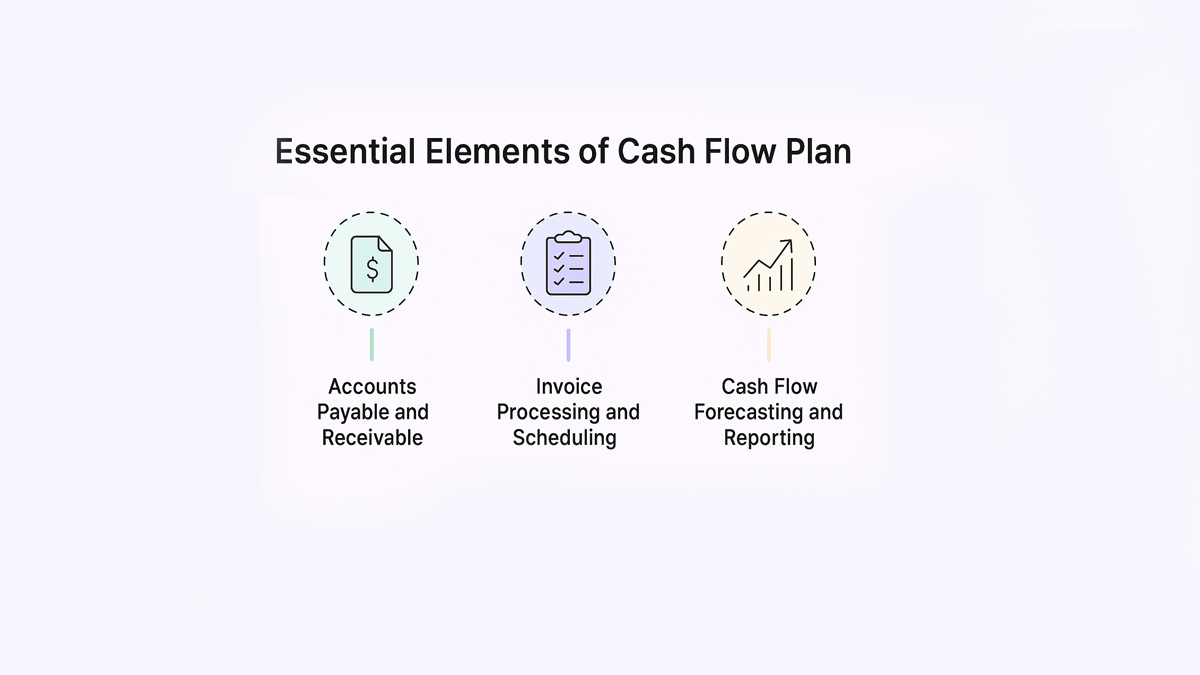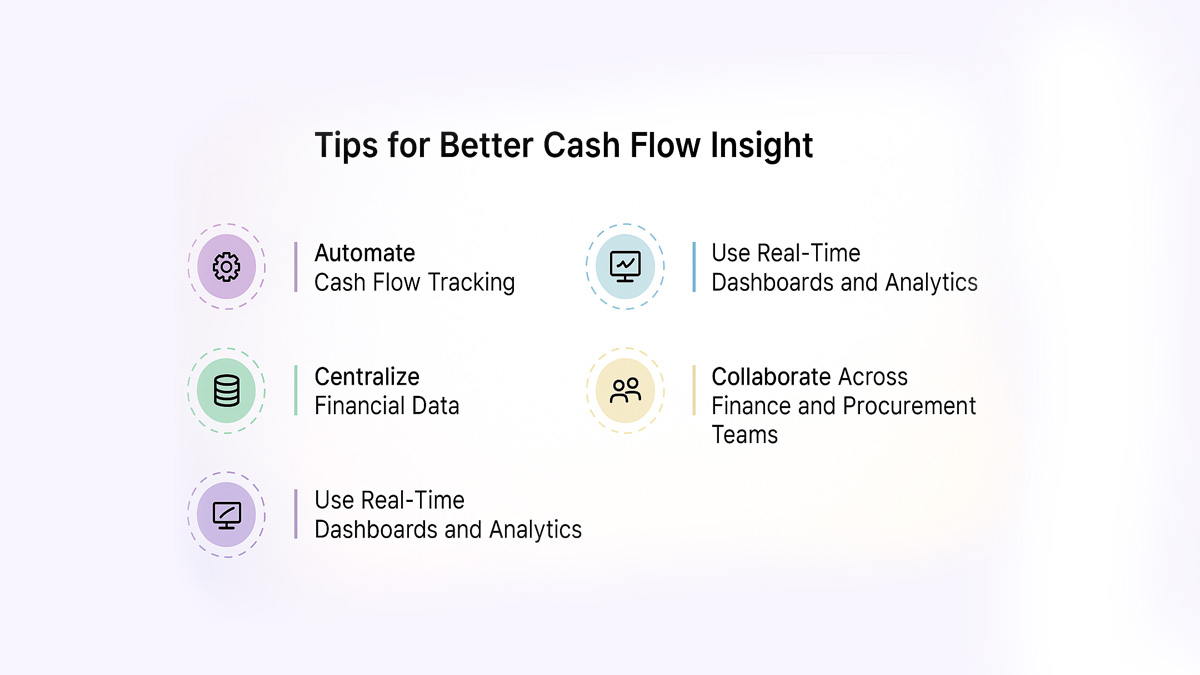

Complete Guide to Cash Flow Management

Complete Guide to Cash Flow Management
Master cash flow management with strategies, automation tips, and forecasting to improve visibility, reduce risks, and strengthen financial health.


Healthy cash flow is the lifeblood of every successful business. Without it, even profitable companies can find themselves unable to pay suppliers, cover expenses, or invest in growth. That’s why cash flow management is more than just a financial practice - it’s a survival strategy. Cash flow challenges can impact both startups and small businesses significantly.
In this guide, we’ll cover everything you need to know about managing your business’s cash flow effectively. From the core components and common challenges to automation tips and Spendflo’s role in simplifying it all - this blog has you covered.
What’s included in this blog:
- What is cash flow management?
- Why effective cash flow management is critical to business survival
- Key components of a cash flow management strategy
- Common challenges in managing business cash flow
- Tips to improve cash flow visibility and forecasting
- How automation strengthens cash flow management
- How Spendflo supports smarter cash flow management for finance leaders
- Frequently asked questions on cash flow management
What is Cash Flow Management?
Cash flow management refers to the process of tracking, analyzing, and optimizing the amount of cash that flows in and out of a business over a specific period. It ensures that a company has enough cash to meet its financial obligations, make informed investment decisions, and avoid liquidity crises.
It’s the foundation of financial health - ensuring you’re never caught off guard when vendor payments, payroll, or unexpected costs hit.
Why Effective Cash Flow Management Is Critical to Business Survival
Managing cash flow helps businesses prevent shortages, maintain healthy vendor relationships, and avoid penalties or credit issues. It gives finance teams the power to act early, rather than react too late.
Here’s why strong cash flow management is non-negotiable:
Prevents Cash Shortages
Running out of cash - even temporarily - can stall operations and damage your business reputation. Effective cash flow tracking ensures you always have enough on hand to cover essential expenses.
Strengthens Financial Health
Regular cash flow forecasting helps businesses plan for slow months and capitalize on strong ones. It gives leadership the confidence to make investment decisions backed by data. A cash flow statement offers a detailed view of both cash inflows and outflows, helping you plan with confidence.
Supports Timely Vendor Payments
Late vendor payments can lead to strained supplier relationships, late fees, or even halted services. It also helps companies plan better for financing activities such as loans or capital investments. A well-managed cash flow ensures vendors are paid on time, improving trust and negotiating power.
Protects Credit Ratings
Cash mismanagement can result in missed payments and hurt your credit rating. This could increase borrowing costs or reduce access to working capital when you need it most.
Key Components of a Cash Flow Management Strategy
A strong cash flow strategy depends on a clear understanding of your incoming and outgoing funds. Here are the building blocks that matter most:

Classify your cash flows under:
- Operating Cash Flow (CFO): day-to-day income and expenses
- Investing Cash Flow (CFI): assets bought or investment returns
- Financing Cash Flow (CFF): loans, equity, or dividends
These help you understand which part of your business generates or consumes the most cash. This segmentation aligns closely with what you’ll see in your balance sheet under operating, investing, and financing activities.
Accounts Payable and Receivable
Tracking Accounts Payable (AP) and Accounts Receivable (AR) ensures timely vendor payments and faster collections. Businesses that fail to manage this often face cash gaps. It also impacts your ability to forecast and control day-to-day operating activities.
Invoice Processing and Payment Scheduling
Delayed or missed payments can lead to late fees and interest charges. An efficient invoice process with scheduled payments smooths out cash flow and avoids penalties.
Cash Flow Forecasting and Reporting
Forecasting helps predict future cash positions based on historical data, planned revenue, and expected expenses. Regular reporting ensures real-time insights and quick adjustments. Careful monitoring of cash outflows also helps reduce late fees and optimize working capital.
Common Challenges in Managing Business Cash Flow
Even well-run businesses struggle with cash flow when visibility, control, or accuracy are lacking. These are the most common hurdles:
- Inaccurate Forecasting: Forecasting based on guesswork instead of real data can lead to poor decision-making. Inaccurate models often miss hidden costs or seasonal dips. Creating a monthly cash flow forecast can reduce the risk of underestimating short-term obligations.
- Poor Visibility and Data Silos: When financial data is scattered across systems or departments, it's hard to get a full picture. This results in missed opportunities, misaligned payments, and reactive decisions. Financial management becomes even more difficult when departments aren’t aligned on priorities.
- Manual Processes and Delayed Payments: Manual invoice processing or spreadsheet-based cash tracking introduces errors. Delays in approvals or lost invoices can throw off entire payment cycles. Automated invoice discounting options can unlock early access to cash tied up in receivables.
- Unexpected Expenses or Seasonal Fluctuations: Emergencies or seasonal slumps can dry up cash fast. Without reserves or forecasting, businesses may be forced to take costly loans or cut operations.
Tips to Improve Cash Flow Visibility and Forecasting
Want to manage cash flow better? Start with visibility and accurate forecasting.

Automate Cash Flow Tracking
Use platforms that automatically record transactions, categorize cash flows, and alert you to anomalies. This removes manual effort and improves accuracy. Bank account reconciliation is key to ensuring your books match actual cash movements.
Centralize Financial Data
Pull data from multiple departments and tools into one dashboard. Centralization helps reduce data silos and offers a unified view of cash status. A clear view of your cash flow forecast enables more agile, informed decisions.
Use Real-Time Dashboards and Analytics
Real-time tools enable finance teams to respond faster to dips, delays, or rising costs. Analytics help spot trends and optimize payment cycles. Predictive modeling can also help forecast potential shortfalls and seasonal spikes.
Collaborate Across Finance and Procurement Teams
Cash flow isn’t only a finance concern - procurement plays a key role too. Streamline vendor onboarding, approval workflows, and contract renewals for smoother operations.
How Automation Strengthens Cash Flow Management
Automating cash flow processes means fewer errors, faster decisions, and better compliance.
Here’s how automation strengthens every aspect:
Reduced Manual Errors and Late Fees
Automated invoice matching, reminders, and approvals ensure no payment slips through the cracks - minimizing costly late fees or double payments.
Faster Invoice Processing and Approvals
Automated Accounts Payable (AP) tools speed up vendor payment cycles, reducing bottlenecks while giving finance leaders better visibility into outstanding obligations. It also supports accurate financial reports and audit-ready documentation.
Improved Control and Visibility
Automation platforms give granular control over payment terms, invoice tracking, and real-time dashboards - ensuring visibility over every dollar moving through the business.
Stronger Fraud Prevention and Compliance
With built-in audit trails, approval workflows, and anomaly detection, automation reduces the risk of fraud and strengthens your compliance posture.
How Spendflo Supports Smarter Cash Flow Management
Spendflo helps finance and procurement teams unlock control and visibility into their software and vendor spend - key components of overall cash flow health.
Here’s how:
Vendor Payment Optimization: Spendflo tracks all SaaS contracts and renewal schedules, ensuring timely payments and preventing unplanned cash leaks. It also helps you budget for capital expenditures by aligning renewal timelines with cash availability.
AP Automation & Visibility: Integrates with your procurement workflows, giving complete visibility into upcoming payments, obligations, and spend commitments.
Forecasting Tools: Aligns upcoming software renewals and contract milestones with your financial plans to avoid cash flow shocks.
SaaS Stack Consolidation: By identifying duplicate tools and unnecessary licenses, Spendflo reduces recurring expenses - freeing up monthly cash reserves.
Strategic Negotiation Support: Our embedded procurement team ensures that every dollar spent on SaaS or vendors is justified, timely, and optimized. For businesses managing tight liquidity, Spendflo can also help explore a line of credit to manage vendor expenses
Spendflo empowers finance leaders to turn unpredictable software costs into manageable, forecastable cash flows.
Conclusion
Effective cash flow management isn’t just a finance team’s job - it’s a business-wide priority. When cash is managed with visibility, automation, and collaboration, companies can operate with confidence, pay vendors on time, and grow without surprise bottlenecks.
Spendflo helps finance leaders take charge of their cash flow by providing full visibility into procurement, contract renewals, and software spend - reducing financial waste and creating predictable, healthy cash movement.
Frequently Asked Questions on Cash Flow Management
What are the benefits of cash flow management?
Cash flow management helps businesses prevent shortages, ensure timely payments, reduce unnecessary expenses, and make smarter financial decisions based on real-time data.
How does automation improve cash flow management?
Automation speeds up invoice approvals, ensures accurate forecasting, reduces manual errors, and improves visibility - leading to better control and fewer late payments.
What’s the difference between cash flow and profit?
Profit is the amount left after expenses are deducted from revenue. Cash flow tracks the actual movement of cash in and out of the business, which determines liquidity.
What tools help with cash flow forecasting?
Cash flow forecasting tools include spreadsheet templates, accounting software (like QuickBooks), and specialized platforms like Spendflo that integrate forecasting with vendor and SaaS spend.
How often should cash flow be reviewed?
Weekly or bi-weekly reviews are ideal for most businesses. Regular reviews help catch potential shortfalls early and keep financial plans aligned with real-time data.
What is the role of a cash flow statement in business planning?
A cash flow statement gives a complete picture of how cash moves through your business. It helps track cash inflows from sales, as well as outflows from expenses and investments. This document is essential for financial reporting and long-term planning.
Can invoice discounting improve business cash flow?
Yes, invoice discounting is a financing method that lets businesses access funds before customer payments are due. It helps smooth out cash flow cycles, especially when facing delayed receivables or seasonal demand fluctuations.









.png)





.png)










.avif)





